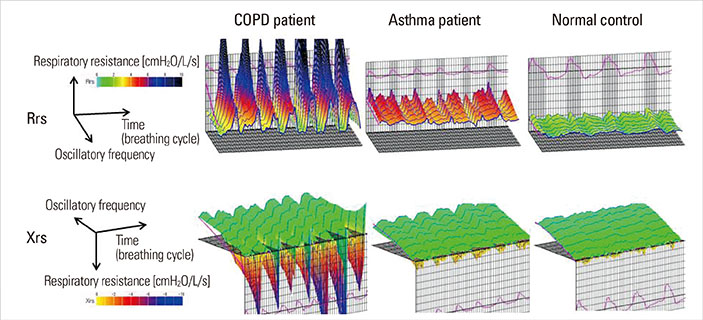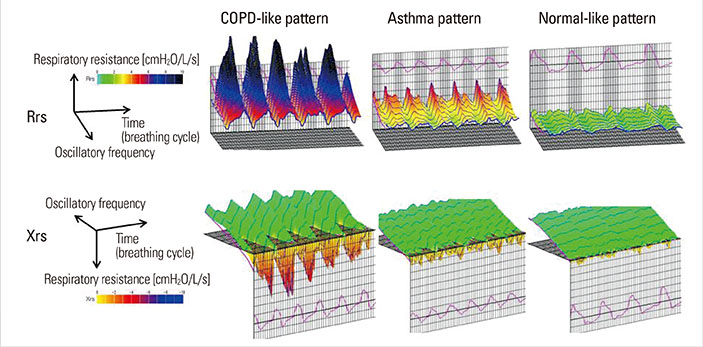Allergy Asthma Immunol Res.
2013 Sep;5(5):322-328. 10.4168/aair.2013.5.5.322.
Usefulness of Colored 3D Imaging of Respiratory Impedance in Asthma
- Affiliations
-
- 1Department of Respiratory Medicine, Shizuoka General Hospital, Shizuoka, Japan. tmjkshi@general-hosp.pref.shizuoka.jp
- 2Second Department of Internal Medicine, Hamamatsu University School of Medicine, Hamamatsu, Japan.
- KMID: 2260814
- DOI: http://doi.org/10.4168/aair.2013.5.5.322
Abstract
- PURPOSE
Recently, the clinical application of the forced oscillation technique (FOT) has progressed with the spread of commercially available FOT devices, including the impulse oscillation system and MostGraph. We investigated the usefulness of color 3D imaging of respiratory impedance in asthma using MostGraph.
METHODS
Whole-breath and within-breath respiratory system resistance (Rrs) and reactance (Xrs) were measured in 78 patients with asthma. Color 3D images were classified into three patterns: the chronic obstructive pulmonary disease (COPD)-like pattern (high values of Rrs and Xrs with a marked respiratory cycle and frequency dependence), the asthma pattern (moderately high Rrs over the entire frequency and a respiratory cycle with slight Xrs changes), and a normal-like pattern (low Rrs and Xrs with few within-breath changes). The classification was performed by three researchers, who were unaware of the clinical information, and the clinical characteristics were compared among the three groups.
RESULTS
Color 3D imaging provided a COPD-like pattern in 25 patients, an asthma pattern in 39 patients, and a normal-like pattern in 14 patients. Patients with the COPD-like pattern were predominantly female with a higher body mass index, lower forced expiratory volume in 1 second (FEV1) and forced vital capacity (FVC), and higher Rrs and Xrs values (whole-breath and within-breath variation). Those with the normal pattern had higher FEV1 and FVC, and a lower single-breath nitrogen washout slope. There were no differences in asthma control or exhaled nitric oxide levels among the three groups.
CONCLUSIONS
These results suggest that color 3D imaging of respiratory impedance may show asthma phenotypes.
MeSH Terms
Figure
Reference
-
1. Oostveen E, MacLeod D, Lorino H, Farré R, Hantos Z, Desager K, Marchal F. ERS Task Force on Respiratory Impedance Measurements. The forced oscillation technique in clinical practice: methodology, recommendations and future developments. Eur Respir J. 2003; 22:1026–1041.2. Hellinckx J, Cauberghs M, De Boeck K, Demedts M. Evaluation of impulse oscillation system: comparison with forced oscillation technique and body plethysmography. Eur Respir J. 2001; 18:564–570.3. Paredi P, Goldman M, Alamen A, Ausin P, Usmani OS, Pride NB, Barnes PJ. Comparison of inspiratory and expiratory resistance and reactance in patients with asthma and chronic obstructive pulmonary disease. Thorax. 2010; 65:263–267.4. Kanda S, Fujimoto K, Komatsu Y, Yasuo M, Hanaoka M, Kubo K. Evaluation of respiratory impedance in asthma and COPD by an impulse oscillation system. Intern Med. 2010; 49:23–30.5. Yamaguchi M, Niimi A, Ueda T, Takemura M, Matsuoka H, Jinnai M, Otsuka K, Oguma T, Takeda T, Ito I, Matsumoto H, Hirai T, Chin K, Mishima M. Effect of inhaled corticosteroids on small airways in asthma: investigation using impulse oscillometry. Pulm Pharmacol Ther. 2009; 22:326–332.6. Kurosawa H, Ohishi J, Shimizu Y, Tasaku Y, Kobayashi D, Masuda M, Kanezaki M, Nikkuni E, Kohzuki M, Hida W. A new method to assess lung volume dependency of respiratory system resistance using forced oscillation [abstract]. Am J Respir Crit Care Med. 2010; 181:A1240.7. Mori K, Shirai T, Mikamo M, Shishido Y, Akita T, Morita S, Asada K, Fujii M, Suda T, Chida K. Colored 3-dimensional analyses of respiratory resistance and reactance in COPD and asthma. COPD. 2011; 8:456–463.8. Global Initiative for Asthma. Global strategy for asthma management and prevention 2011. United States: Global Initiative for Asthma;2011. updated 2011 Dec. cited 2012 Feb. Available from: http://www.ginasthma.org.9. Ohta K, Yamaguchi M, Akiyama K, Adachi M, Ichinose M, Takahashi K, Nishimuta T, Morikawa A, Nishima S. Japanese guideline for adult asthma. Allergol Int. 2011; 60:115–145.10. Nathan RA, Sorkness CA, Kosinski M, Schatz M, Li JT, Marcus P, Murray JJ, Pendergraft TB. Development of the asthma control test: a survey for assessing asthma control. J Allergy Clin Immunol. 2004; 113:59–65.11. Dellacà RL, Pompilio PP, Walker PP, Duffy N, Pedotti A, Calverley PM. Effect of bronchodilation on expiratory flow limitation and resting lung mechanics in COPD. Eur Respir J. 2009; 33:1329–1337.12. American Thoracic Society. European Respiratory Society. ATS/ERS recommendations for standardized procedures for the online and offline measurement of exhaled lower respiratory nitric oxide and nasal nitric oxide, 2005. Am J Respir Crit Care Med. 2005; 171:912–930.13. Tsoukias NM, George SC. A two-compartment model of pulmonary nitric oxide exchange dynamics. J Appl Physiol. 1998; 85:653–666.14. Condorelli P, Shin HW, Aledia AS, Silkoff PE, George SC. A simple technique to characterize proximal and peripheral nitric oxide exchange using constant flow exhalations and an axial diffusion model. J Appl Physiol. 2007; 102:417–425.15. American Thoracic Society. Standardization of spirometry, 1994 update. Am J Respir Crit Care Med. 1995; 152:1107–1136.16. Kanazawa H, Tochino Y, Kyoh S, Ichimaru Y, Asai K, Hirata K. Potential roles of pentosidine in age-related and disease-related impairment of pulmonary functions in patients with asthma. J Allergy Clin Immunol. 2011; 127:899–904.17. Dellacà RL, Santus P, Aliverti A, Stevenson N, Centanni S, Macklem PT, Pedotti A, Calverley PM. Detection of expiratory flow limitation in COPD using the forced oscillation technique. Eur Respir J. 2004; 23:232–240.18. Gelb AF, Zamel N. Unsuspected pseudophysiologic emphysema in chronic persistent asthma. Am J Respir Crit Care Med. 2000; 162:1778–1782.19. Mauad T, Silva LF, Santos MA, Grinberg L, Bernardi FD, Martins MA, Saldiva PH, Dolhnikoff M. Abnormal alveolar attachments with decreased elastic fiber content in distal lung in fatal asthma. Am J Respir Crit Care Med. 2004; 170:857–862.20. Finucane KE, Greville HW, Brown PJ. Irreversible airflow obstruction. Evolution in asthma. Med J Aust. 1985; 142:602–604.21. Gelb AF, Schein A, Nussbaum E, Shinar CM, Aelony Y, Aharonian H, Zamel N. Risk factors for near-fatal asthma. Chest. 2004; 126:1138–1146.22. West JB. Mechanics of breathing. In : West JB, editor. Respiratory physiology: the essentials. 9th ed. Baltimore, MD: Lippincott Williams & Wilkins;2012.
- Full Text Links
- Actions
-
Cited
- CITED
-
- Close
- Share
- Similar articles
-
- Clinical usefulness of impulse oscillometry(IOS) in bronchial asthma
- The Usefulness of Reconstructed 3D Images in Surgical Planning for Cochlear Implantation in a Malformed Ear with an Abnormal Course of the Facial Nerve
- Clinical Applications of Forced Oscillation Techniques (FOT) in Patients with Bronchial Asthma
- Respiratory Syncytial Virus Bronchiolitis and Childhood Asthma
- Interactions between Upper Respiratory Infection and Development of Wheezing and Asthma in Children



